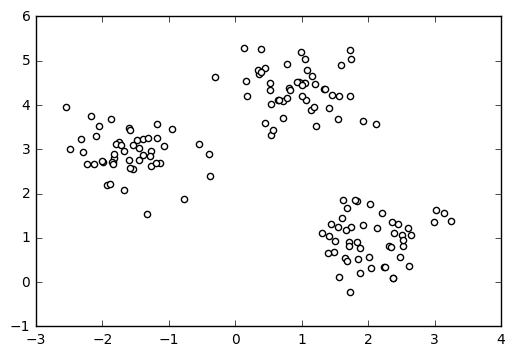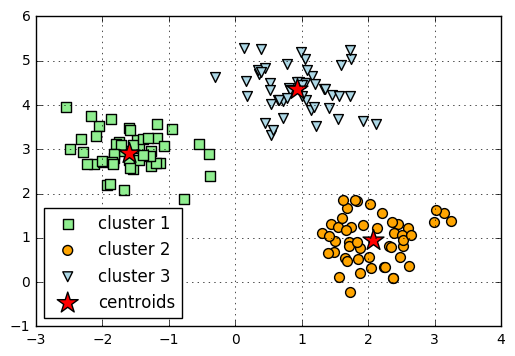Kmeans: k-means clustering
A implementation of k-means clustering.
from mlxtend.cluster import Kmeans
Overview
Clustering falls into the category of unsupervised learning, a subfield of machine learning where the ground truth labels are not available to us in real-world applications. In clustering, our goal is to group samples by similarity (in k-means: Euclidean distance).
The k-means algorithms can be summarized as follows:
- Randomly pick k centroids from the sample points as initial cluster centers.
- Assign each sample to the nearest centroid .
- Move the centroids to the center of the samples that were assigned to it.
- Repeat steps 2 and 3 until the cluster assignments do not change or a user-defined tolerance or a maximum number of iterations is reached.
References
- MacQueen, J. B. (1967). Some Methods for classification and Analysis of Multivariate Observations. Proceedings of 5th Berkeley Symposium on Mathematical Statistics and Probability. University of California Press. pp. 281–297. MR 0214227. Zbl 0214.46201. Retrieved 2009-04-07.
Example 1 - Three Blobs
Load some sample data:
import matplotlib.pyplot as plt
from mlxtend.data import three_blobs_data
X, y = three_blobs_data()
plt.scatter(X[:, 0], X[:, 1], c='white')
plt.show()

Compute the cluster centroids:
from mlxtend.cluster import Kmeans
km = Kmeans(k=3,
max_iter=50,
random_seed=1,
print_progress=3)
km.fit(X)
print('Iterations until convergence:', km.iterations_)
print('Final centroids:\n', km.centroids_)
Iteration: 2/50 | Elapsed: 00:00:00 | ETA: 00:00:00
Iterations until convergence: 2
Final centroids:
[[-1.5947298 2.92236966]
[ 2.06521743 0.96137409]
[ 0.9329651 4.35420713]]
Visualize the cluster memberships:
y_clust = km.predict(X)
plt.scatter(X[y_clust == 0, 0],
X[y_clust == 0, 1],
s=50,
c='lightgreen',
marker='s',
label='cluster 1')
plt.scatter(X[y_clust == 1,0],
X[y_clust == 1,1],
s=50,
c='orange',
marker='o',
label='cluster 2')
plt.scatter(X[y_clust == 2,0],
X[y_clust == 2,1],
s=50,
c='lightblue',
marker='v',
label='cluster 3')
plt.scatter(km.centroids_[:,0],
km.centroids_[:,1],
s=250,
marker='*',
c='red',
label='centroids')
plt.legend(loc='lower left',
scatterpoints=1)
plt.grid()
plt.show()

API
Kmeans(k, max_iter=10, convergence_tolerance=1e-05, random_seed=None, print_progress=0)
K-means clustering class.
Added in 0.4.1dev
Parameters
-
k: intNumber of clusters
-
max_iter: int (default: 10)Number of iterations during cluster assignment. Cluster re-assignment stops automatically when the algorithm converged.
-
convergence_tolerance: float (default: 1e-05)Compares current centroids with centroids of the previous iteration using the given tolerance (a small positive float)to determine if the algorithm converged early.
-
random_seed: int (default: None)Set random state for the initial centroid assignment.
-
print_progress: int (default: 0)Prints progress in fitting to stderr. 0: No output 1: Iterations elapsed 2: 1 plus time elapsed 3: 2 plus estimated time until completion
Attributes
-
centroids_: 2d-array, shape={k, n_features}Feature values of the k cluster centroids.
-
custers_: dictionaryThe cluster assignments stored as a Python dictionary; the dictionary keys denote the cluster indeces and the items are Python lists of the sample indices that were assigned to each cluster.
-
iterations_: intNumber of iterations until convergence.
Examples
For usage examples, please see https://rasbt.github.io/mlxtend/user_guide/classifier/Kmeans/
Methods
fit(X, init_params=True)
Learn model from training data.
Parameters
-
X: {array-like, sparse matrix}, shape = [n_samples, n_features]Training vectors, where n_samples is the number of samples and n_features is the number of features.
-
init_params: bool (default: True)Re-initializes model parameters prior to fitting. Set False to continue training with weights from a previous model fitting.
Returns
self: object
predict(X)
Predict targets from X.
Parameters
-
X: {array-like, sparse matrix}, shape = [n_samples, n_features]Training vectors, where n_samples is the number of samples and n_features is the number of features.
Returns
-
target_values: array-like, shape = [n_samples]Predicted target values.